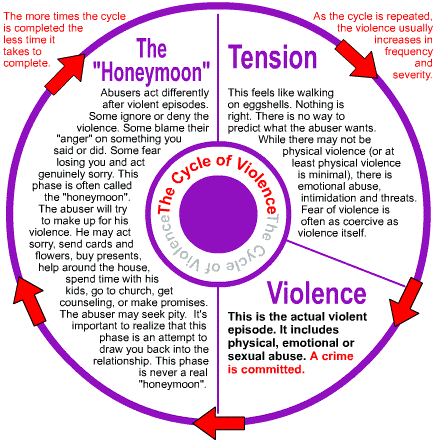- About Us
- Services Offered
-
Information
- YouTube Links
- Ride Sharing
- Victim Advocacy: Guide to Supporting Survivors of Domestic Violence
- What Is Domestic Violence?
- What is Sexual Assault?
- Who Is At Risk?
- Healthy Relationships
- Are You In A Violent Relationship?
- Family & Friends of Victims
- Teen Dating Violence
- Safety with Technology >
- Local, State & National Contacts
- Statistics & Facts
- News & Events
- How Can You Help?
- Contact Us
- Downloadable Forms
What is Domestic Violence?
Domestic Violence is a term applied to a variety of behaviors, inclusive of, though not restricted to, physical violence, sexual violence, intimidation, stalking, economic abuse, and psychological/emotional abuse. The ultimate goal of the abuser in a domestically violent relationship is to gain control over the victim. When one person in a relationship repeatedly scares, hurts or puts down the other person, IT IS ABUSE. Abuse is much more than slapping or grabbing someone. Below are some ways a person can try to exert power and control over another.
|
INTIMIDATION:
Yelling or Screaming Using a threatening tone Talking down to a partner Threatening to hurt self/partner Making partner feel afraid Tearing up pictures Smashing gifts Destroying objects |
SEXUAL & PHYSICAL ABUSE
Bragging about sexual relationships Pressuring partner Negatively comparing to past partner(s) Rape Using drugs/alcohol to get sex Restraining partner Slamming into locker or wall Slapping Shoving Punching Kicking Spitting |
|
THREATS
Will commit suicide if you break up Saying he/she can't live without you Constantly threatening to leave you Constantly threatening to find someone else Will hurt you if you try to leave |
DOMINATION
Treating partner like a baby, property, or servant Making all the decisions Having expectations that no one can meet Controlling who partner sees or spends time with Setting all of the rules in the relationship |
|
HUMILIATION
Putting down partner Name calling Objectifying Constant criticism Making partner feel crazy Making partner feel guilty Embarrassing/humiliating partner |
POSSESSIVENESS
Using jealousy as a sign of love Accusing partner of cheating Not letting partner have friends Telling how to think, dress, act |
MINIMIZATION & BLAME
Not accepting responsibility for actions Making a joke when partner is hurt Telling partner that everything is his/her fault Acting like abuse is okay the relationship |
Cycle of Abuse
Abusers go through a series of emotions and rationalizations that allow them to justify their abuse. See the Cycle of Violence Wheel below for more information.
ABUSE: Rape, battery, incest, emotional abuse, murder, etc.
GUILT: Not normal guilt, but self-directed guilt.
RATIONALIZATION: Excuses the behavior by blaming the victim.
NORMAL BEHAVIOR/HONEYMOON STAGE: This is the stage where the abuser engages in normal behavior. This is when the batterer brings flowers and gifts to the partner and is thoughtful and kind.
FANTASY: The deviant, sexually aggressive fantasy. The abuser fantasizes about past and future abuse.
PLANNING: This is the stage where the abuser thinks about what he/she will need to have and do so that they can abuse again. If the plan is to be drunk in order to abuse the partner, they know they will have to buy alcohol.
SETTING UP: The abuser sets up the conditions so that the abuse can occur. A batterer may buy the alcohol and drink
it.
ABUSE: Rape, battery, incest, emotional abuse, murder, etc.
GUILT: Not normal guilt, but self-directed guilt.
RATIONALIZATION: Excuses the behavior by blaming the victim.
NORMAL BEHAVIOR/HONEYMOON STAGE: This is the stage where the abuser engages in normal behavior. This is when the batterer brings flowers and gifts to the partner and is thoughtful and kind.
FANTASY: The deviant, sexually aggressive fantasy. The abuser fantasizes about past and future abuse.
PLANNING: This is the stage where the abuser thinks about what he/she will need to have and do so that they can abuse again. If the plan is to be drunk in order to abuse the partner, they know they will have to buy alcohol.
SETTING UP: The abuser sets up the conditions so that the abuse can occur. A batterer may buy the alcohol and drink
it.
Financial Harm is a big part of Domestic Violence, please click on the link below for more information regarding this type of abuse.
Proudly powered by Weebly
- About Us
- Services Offered
-
Information
- YouTube Links
- Ride Sharing
- Victim Advocacy: Guide to Supporting Survivors of Domestic Violence
- What Is Domestic Violence?
- What is Sexual Assault?
- Who Is At Risk?
- Healthy Relationships
- Are You In A Violent Relationship?
- Family & Friends of Victims
- Teen Dating Violence
- Safety with Technology >
- Local, State & National Contacts
- Statistics & Facts
- News & Events
- How Can You Help?
- Contact Us
- Downloadable Forms
